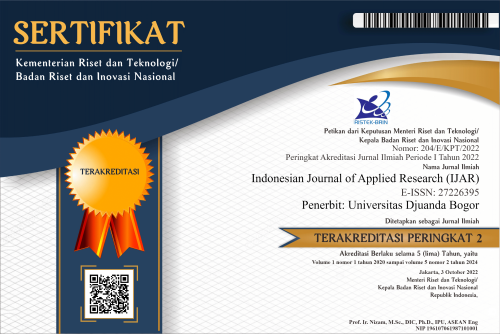Contribution of Riparian Vegetation to Water Quality in Spring Water Oras
Abstract
Soba Village, West Amarasi Subdistrict, Kupang Regency is located in East Nusa Tenggara Province with abundant natural resources. One of the natural resources is a natural spring with abundant diversity of riparian vegetation. The diversity of riparian vegetation around water sources plays an important role in water quality. This study aimed to identify the diversity of riparian vegetation around springs and to determine water quality. The method used was plot installation, identification of riparian vegetation types, measurement of environmental factors and water quality testing. The results showed that there were 12 species of tree vegetation with a total of 74 individuals, the most common tree species found was Canangan odorata with a relative abundance of 24.32%, followed by Cocos nucifera 18.92%, and Areca sp. 16.22%. Meanwhile, the least species found were Tectona grandis, Mangifera indica, Artocarpus altilis, and Syzygium aqueum with relative species abundance of 1.35%. The results of quantitative analysis of the relative frequency found tree species Areca sp. and Cocos nucifera had the highest value, namely 19.05%. Meanwhile, the highest relative dominance value was found in thespecies Artocarpus altilis. The results of water quality testing with 3 parameters namely physical, chemical and bacteriological showed a COD value of 85.03 mg / L, a total colifrorm of 45 and a total fecal colliform of 230
References
Agustiningsih, D., Sasongko, S.D., Sudarno. 2012. Analisis Kualitas Air dan Strategi Pengendalian Pencemaran Air Sungai Blukar Kabupaten Kendal. Laporan Penelitian Kesehatan Masyarakat. Universitas Diponegoro. Semarang.
Fischer R., C. O. Martin, & J. C. Fischenich. 2000. Improving riparian buffer strip and corridors for water quality and wildlife. International conference on Riparian Ecology and Management in Multiland use watersheds American Water Resources Association.
Ghermandi A., V. Vandenberghe, L. Benedetti, W. Bauwens & P. A. Vanrolleghemb.2009. Model-Based Assessment of Shading Effect by Riparian Vegetation on River Water Quality. Ecological Engineering, 35 : 92-104.
Hidayat, G. 2013. Kajian Optimalisasi dan Strategi Sumber Daya Air di Kabupaten Rembang, Jawa Tengah. Tesis. Universitas Diponegoro. Semarang.
Indriyanto. Ekologi Hutan. Jakarta: Bumi Aksara, 2005.
Lüscher P, Zürcher K. 2003. Flood Protection in Forests. Report of the
Bavarian State Institute of Forestry, Report No. 40. Freising: Bavarian
State Institute of Forestry.
Pakulnicka J, P. Buczy´nski, P. D˛abkowski, E. Buczy´nska, E. St˛epie´n, R. Stryjecki, A. Szlauer-Łukaszewska and A. Zawal. 2016. Aquatic beetles (Coleoptera) in springs of a small lowland river: habitat factors vs. landscape factors. Knowledge & Management of Aquatic Ecosystems. 417 (29).
Semiun, C. G., Lengur E. R. A. 2018. The Profile of Riparian Tree Grown in the Area of Water Springs in Kupang, Nusa Tenggara Timur Province Indonesia. International Journal of Sciences: Basic and Applied Research, 42 (5): 75-83.
Solano, R. 2003. “Riparian Zone Land Use in Indigenous and Colonist Communities of The Palcazu Basin, Peruvian Amazon,” presented at meeting Latin American Studies Association, Dallas, Texas.
Sutrisno, C.T. 2000. Teknologi Penyediaan air bersih. Rineka Cipta. Jakarta
Trimanto. 2013. Diversitas pohon sekitar aliran mata air di Kawasan Pulau Moyo Nusa Tenggara Barat. Prosiding Seminar Nasional X Pendidikan Biologi FKIP UNS Surakarta.
Copyright (c) 2021 Indonesian Journal of Applied Research (IJAR)

This work is licensed under a Creative Commons Attribution-ShareAlike 4.0 International License.
The Authors submitting a manuscript do so on the understanding that if accepted for publication, copyright publishing of the article shall be assigned/transferred to Indonesian Journal of Applied Research (IJAR) Universitas Djuanda as Publisher of the journal. Upon acceptance of an article, authors will be asked to complete a 'Copyright Transfer Agreement'. An e-mail will be sent to the corresponding author confirming receipt of the manuscript together with a 'Copyright Transfer Agreement' form by online version of this agreement.
Indonesian Journal of Applied Research (IJAR) Universitas Djuanda, the Editors and the Editorial Board make every effort to ensure that no wrong or misleading data, opinions or statements be published in the journal. In any way, the contents of the articles and advertisements published in the Indonesian Journal of Applied Research (IJAR) Universitas Djuanda are sole and exclusive responsibility of their respective authors and advertisers.
Remember, even though we ask for a transfer of copyright, our journal authors retain (or are granted back) significant scholarly rights as mention before.
The Copyright Transfer Agreement (CTA) Form can be downloaded here: Copyright Transfer Agreement-IJAR 2020
The copyright form should be signed electronically and send to the Editorial Office e-mail below:
Prof. Dr. Ir. Dede Kardaya, M.Si. (Editor-in-Chief)
Universitas Djuanda
Jl. Tol Jagorawi No.1, Ciawi, Kec. Ciawi, Bogor, Jawa Barat 16720
Website: http://journal.unida.ac.id/index.php/IJAR/index
Email: ijar@unida.ac.id






 This work is licensed under a
This work is licensed under a 